Introduction
In the realm of home maintenance, numerous myths can misguide homeowners, leading them down paths that are not only unnecessary but potentially hazardous. One such persistent myth revolves around the belief that the pilot light on a gas furnace must be kept burning at all times. In this article, we will debunk this myth, exploring why it doesn’t need to stay lit and the potential consequences of letting it burn continuously.
The Fallacy of Keeping the Pilot Light On
Why Does the Pilot Light Go Out Anyway?
When you initiate your furnace for the first time in a season, the pilot light ignites, initiating a crucial heating process. This involves heating a small metal rod until it glows orange, causing vapors in the gas pipe to catch fire and produce the heat necessary to warm your home. However, the misconception arises when people believe this pilot light must be left on constantly.
The problem with leaving the pilot light burning perpetually is the accumulation of debris around its base over time. This debris, formed by ash and dust collecting on the unit, obstructs the pilot light, hindering its ability to reach the required heat. Consequently, the furnace may lose prime, necessitating a reset to resume optimal functionality during colder months.
What Happens When You Don’t Turn Off the Pilot Light?
Continuously keeping the pilot light on poses safety risks and potential damage to your furnace. The debris buildup around the base impedes the metal rod’s capacity to reach the necessary temperature for proper functioning. This can lead to a miss-fire scenario where gas enters the home without being burned inside the furnace, creating unsafe conditions. Moreover, the safety issue extends beyond the unit itself.
If the pilot light is not turned off, or it doesn’t shut off automatically, there’s a risk of hazardous gas buildup within your home. The unburned gas can escape through cracks, reaching the outside air. Given that the gas is combustible, a buildup outside, if ignited by a heat source, could result in an explosion.
Debunking the Myth: Turning Off the Pilot Light
Contrary to the myth, it is unnecessary and even unsafe to keep the pilot light on constantly. You can turn off your furnace’s pilot light without any problems or safety concerns. It should only remain lit when you are actively using it. Leaving it on continuously can lead to issues with safety, potential explosions, and higher-than-desired heating bills.
Conclusion: Prioritize Safety and Efficiency
In conclusion, the pilot light is a safety feature that does not require constant burning. Most modern furnaces are designed to shut off the pilot light automatically. If you are unsure about the specific needs of your furnace or encounter any issues, seeking the expertise of professionals.The technicians can diagnose problems, answer questions about your heating system, and ensure that your home remains safe and efficiently heated. Remember, the key to optimal furnace functionality lies in dispelling misconceptions and embracing informed, safe practices.
Disclosure: We may get commissions for purchases made through links in this post.








